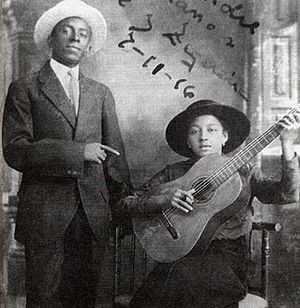María Teresa Vera facts for kids
Quick facts for kids
María Teresa Vera
|
|
|---|---|

María Teresa Vera with Rafael Zequeira in 1916
|
|
| Background information | |
| Birth name | María Teresa Vera |
| Born | February 6, 1895 Guanajay |
| Origin | Guanajay, Cuba |
| Died | December 17, 1965 (aged 70) Havana |
| Genres | Trova |
| Occupations | Singer-songwriter, guitarist |
| Years active | 1911–1962 |
| Associated acts | Rafael Zequeira, Lorenzo Hierrezuelo |
| Influenced by Manuel Corona, Carlos Godínez | |
María Teresa Vera (born February 6, 1895, in Guanajay, Cuba – died December 17, 1965, in Havana, Cuba) was a famous Cuban singer, guitarist, and songwriter. She was a very important artist in the Cuban trova music style.
Contents
Her Musical Journey
María Teresa began her music career in 1911. She sang a song called Mercedes by Manuel Corona in a theater. Her first guitar teacher was José Díaz, who worked rolling cigars. Manuel Corona also helped her learn more about music and taught her how to play his songs on the guitar.
Duos and Groups
From 1916 to 1924, María Teresa sang with Rafael Zequeira as a duo. They recorded over a hundred songs together in New York. Sadly, most of these recordings are now lost. After Rafael Zequeira became ill and passed away, she met Carlos Godinez, a composer. He taught her even more about playing the guitar. Their friendship lasted until he died in 1950.
In 1925, María Teresa formed a music group called the Sexteto Occidente. The group included Miguel García as the main singer and director, Ignacio Piñeiro on double bass, Julio Torres Biart on tres, Manuel Reinoso on bongo, and Francisco Sánchez on maracas. They were all very talented musicians who later had successful careers.
In 1935, she started a new duo with Lorenzo Hierrezuelo. This partnership lasted for 27 years! For much of this time, Hierrezuelo also performed with Compay Segundo (Francisco Repilado) in a duo called Los Compadres.
Famous Songs and Appearances
One of María Teresa's most famous songs is the habanera Veinte años. Many Cuban artists have performed this song. Another well-known song of hers is Sólo pienso en ti, which is a bolero–son.
In 1945, she worked for Circuito CMQ on a radio show called Cosas de Ayer (Things of Yesterday). In the 1950s, she appeared on a TV show called El Casino de la Alegría (The Casino of Joy). María Teresa retired in 1962 and received public honors for her long career.
What Others Said About Her
Many Cuban musicians and composers admired María Teresa Vera.
Silvio Rodríguez, a famous singer-songwriter, said that her voice was "dry" and clear. He noted that she would slide from one note to another, which gave her voice a special charm. He felt her singing sounded natural and easy.
Pablo Milanés, another well-known artist, simply said, "María Teresa is for me the embodiment of Cuban song." This means he saw her as the perfect example of Cuban music.
María Teresa Linares, a music expert, spoke about María Teresa Vera and Lorenzo Hierrezuelo's duo. She believed their 27 years together were the most important time for them. She said their voices and playing reached the highest level, creating the "most sublime expression of the Cuban song."
Tributes
On February 6, 2020, Google honored María Teresa Vera on what would have been her 125th birthday with a special Google Doodle.
See also
 In Spanish: María Teresa Vera para niños
In Spanish: María Teresa Vera para niños


